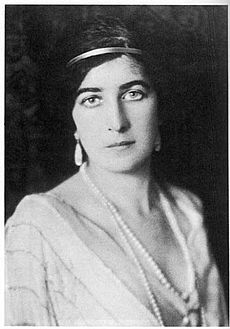Venetia Stanley (1887–1948) facts for kids

Beatrice Venetia Stanley Montagu (born August 22, 1887 – died August 3, 1948) was an important British lady and social figure. She is most famous for the many letters that Prime Minister H. H. Asquith wrote to her. These letters were sent between 1910 and 1915.
Contents
Her Life Story
Venetia was the youngest daughter of Edward Lyulph Stanley, 4th Baron Sheffield and Stanley of Alderley. She was named after an earlier famous lady, Venetia Stanley (1600–1633), who was a distant relative.
Friendship and Letters
Venetia became friends with Asquith through his daughter, Violet. Asquith, who liked writing letters to women in high society, started writing to Venetia in 1910. At first, Venetia was one of several women who received his letters. But in 1912, things changed. She went on a trip to Sicily with Asquith, Violet, and Edwin Montagu. Edwin Montagu was a Liberal MP and a close helper of Asquith. It seems that both Asquith and Montagu developed strong feelings for Venetia during this trip.
Over the next three years, Asquith wrote to Venetia more and more often. He even wrote to her during important government meetings. Venetia also wrote back to Asquith very often. However, Asquith usually destroyed her letters to keep them private. At the same time, Montagu was trying to win Venetia's heart. He asked her to marry him in 1913, but she said no. Venetia liked Montagu, but she did not feel the same love for him. Also, Montagu needed to marry someone of his own Jewish faith to keep his family inheritance. Venetia came from a family with very open beliefs and was not a very religious Anglican. Still, changing her religion to Judaism seemed like a very big step.
Important Advice and Marriage
By early 1915, Asquith was writing Venetia up to three letters a day. He relied on her not just for emotional support. He also asked for her advice on how to work with other politicians. He even asked her about military strategy during the First World War. The letters he wrote to her during government meetings are very important. Sometimes, they are the only records of what happened in those meetings. They help historians understand how Britain planned its war strategy. Venetia was smart, well-read, and very interested in politics. But she felt overwhelmed by Asquith's constant requests for advice.
Because of this, she finally agreed to marry Montagu on April 28, 1915. She wrote to Asquith about her decision on May 12. After she converted to Judaism, Venetia married Montagu on July 26, 1915.
Later Life and Interests
Venetia and Montagu had a daughter named Judith in 1923. Judith later became friends with Princess Margaret during the Second World War. She married an American photographer named Milton Gendel. Together, they created a place for artists and thinkers in Italy.
Venetia's marriage lasted until Montagu's death in 1924. After she became a widow, she became friends with Asquith again. Asquith's last trip before he died in 1928 was a visit to Venetia. In the same year, a political party asked her to run for a seat in Parliament for South Norfolk. She had inherited Montagu's large country house there. But she decided not to run.
After her husband passed away, Venetia became very interested in flying. In 1931, she went on a 6,000-mile adventure. She flew in a small plane called a DH Gypsy Moth. The pilot was Rupert Belleville. Their journey took them across Russia, the Middle East, and Persia. Venetia said about the trip, "We are going for fun only, in the simplest, cheapest, and most modern way of seeing the world."
Venetia Stanley Montagu died from cancer in 1948. She was almost 61 years old.

